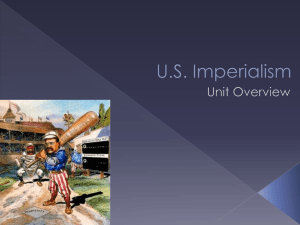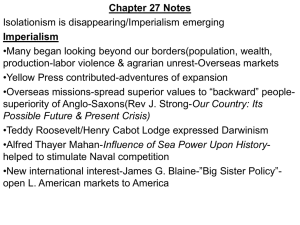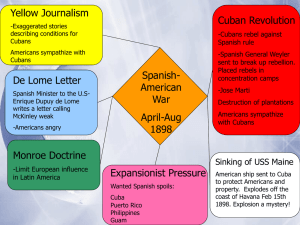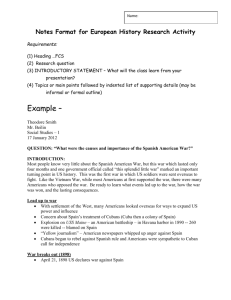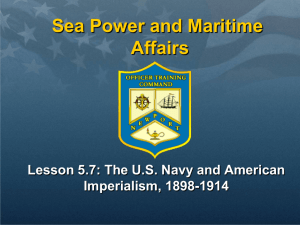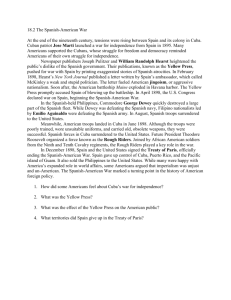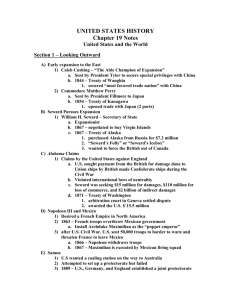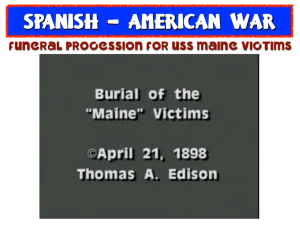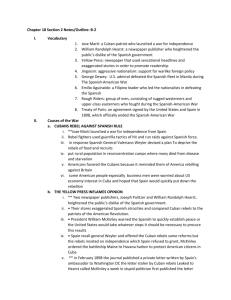1/5/2016
advertisement
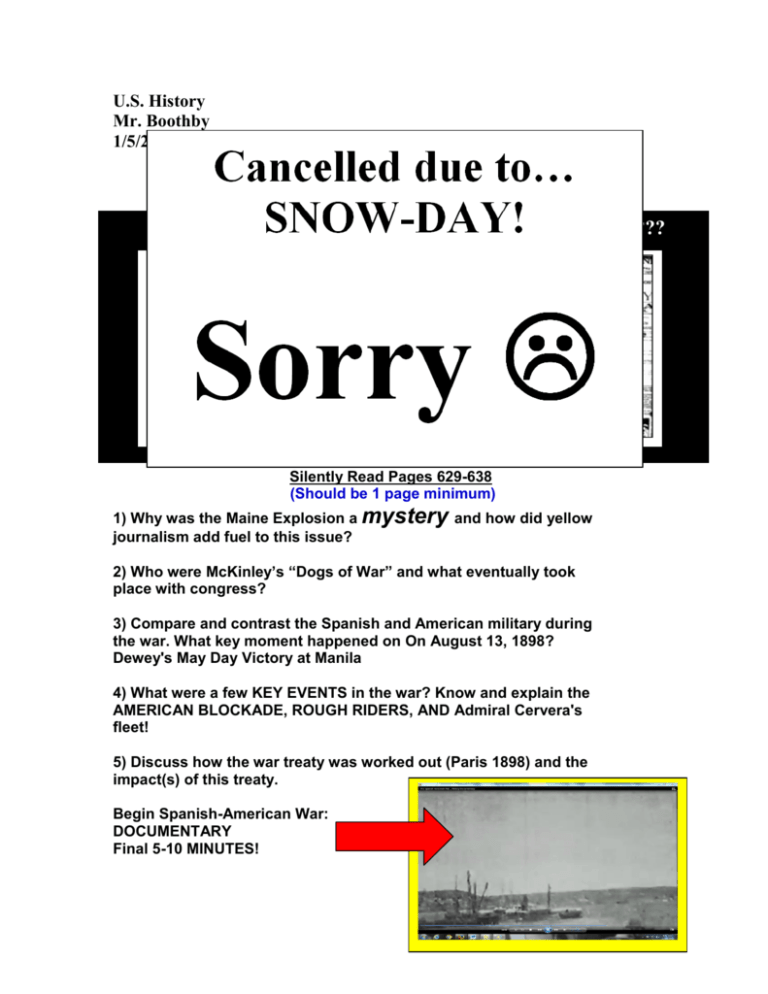
U.S. History Mr. Boothby 1/5/2016 Target Chapter 27: The Path of Empire PT2 http://www.apnotes.net/notes-12e/ch27-12e.html Yellow Journalism/ THE USS MAINE/ SPANISH-AMERICAN WAR 1898 (Teddy R) Reaction: Was War Justified? What REALLY happened??? Silently Read Pages 629-638 (Should be 1 page minimum) 1) Why was the Maine Explosion a mystery and how did yellow journalism add fuel to this issue? 2) Who were McKinley’s “Dogs of War” and what eventually took place with congress? 3) Compare and contrast the Spanish and American military during the war. What key moment happened on On August 13, 1898? Dewey's May Day Victory at Manila 4) What were a few KEY EVENTS in the war? Know and explain the AMERICAN BLOCKADE, ROUGH RIDERS, AND Admiral Cervera's fleet! 5) Discuss how the war treaty was worked out (Paris 1898) and the impact(s) of this treaty. Begin Spanish-American War: DOCUMENTARY Final 5-10 MINUTES! KEY FACTS***he Senate had difficulty passing the Senate. Democratic presidential candidate for the election of 1900, William J. Bryan used his influence on Democratic senators to get the treaty approved on February 6, 1899. Bryan argued that the sooner the treaty was passed, the sooner the Filipinos could gain their independence. EVERYTHING IS DUE TODAY! TONIGHT READ 639-643 PT 3 CH 26 + CORNELL NOTES Support Link HERE http://www.apnotes.net/notes-12e/ch26-12e.html 1) Why was the Maine Explosion a mystery and how did yellow journalism add fuel to this issue? William R. Hearst and Joseph Pulitzer used "yellow journalism" to inflate the anger of the American people over the crisis in Cuba. On February 15, 1898, the American ship, Maine blew up in the Havana port. The Spanish claimed it was an accident (spontaneous combustion in one of the coal bunkers), while the Americans claimed that Spain had sunk it. The American people did not believe the Spanish, and war with Spain became imminent. 2) Who were McKinley’s “Dogs of War” and what eventually took place with congress? Spain had agreed to the Americans' 2 basic demands: an end to the reconstruction camps and an armistice with Cuban rebels. Although President McKinley did not want a war with Spain, the American people did. He conceded to the American people, and he sent his war message to Congress on April 11, 1898. Congress declared war and adopted the Teller Amendment. It said that when the United States had beaten the Spanish, the Cubans would be free. 3) Compare and contrast the Spanish and American military during the war. What key moment happened on On August 13, 1898? Dewey's May Day Victory at Manila The Spanish military significantly outnumbered the American army, but American naval ships were in much better condition than the Spanish. Commodore George Dewey's 6-ship fleet attacked Spain's Philippines on May 1, 1898. Dewey attacked and destroyed the 10-ship Spanish fleet at Manila. German ships threatened to attack Dewey's ships in the Manila harbor (claiming that they wanted to protect German nationals). After several incidents, the potential for conflict with Germany blew over. On August 13, 1898, American troops captured Manila. With the victory in the Philippines, it was thought that Hawaii was needed as a supply base for Dewey. Therefore, Congress passed a joint resolution of Congress to annex Hawaii on July 7, 1898. 4) What were a few KEY EVENTS in the war? Know and explain the AMERICAN BLOCKADE, ROUGH RIDERS, Shortly after the outbreak of the war, the Spanish government sent a fleet of warships to Cuba, led by Admiral Cervera. He was blockaded in the Santiago harbor in Cuba by American ships. The "Rough Riders," was a regiment of American volunteers that was commanded by Colonel Leonard Wood and organized by Theodore Roosevelt. The advancing American army caused the Spanish fleet to retreat from the Santiago harbor. Admiral Cervera's fleet was entirely destroyed on July 3, 1898. General Nelson A. Miles met little resistance when he took over Puerto Rico. On August 12, 1898, Spain signed an armistice. Many more Americans had been killed by malaria, typhoid, and yellow fever than by bullets. 5) Discuss how the war treaty was worked out (Paris 1898) and the impact(s) of this treaty. Spanish and Americans met in Paris in 1898 to discuss terms to the end of the war. The Americans secured Guam and Puerto Rico, but the Philippines presented President McKinley with a problem: he didn't want to give the island back to the Spanish, but he also didn't want to leave the island in a state of disarray. McKinley finally decided to Christianize all of the Filipinos. Because Manila had been captured the day after the war, America agreed to pay Spain $20 million for the Philippines. The Anti-Imperialistic League fought McKinley's expansionist moves, in regards to the Phillippines.
